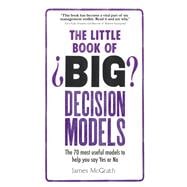Leaders and Managers want quick answers, quick ways to reach solutions, ways and means to access knowledge that won’t eat into their precious time and quick ideas that deliver a big result. The Little Book of Big Decision Models cuts through all the noise and gives managers access to the very best decision-making models that they need to to keep things moving forward. Every model is quick and easy to read and delivers the essential information and know-how quickly, efficiently and memorably.








